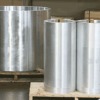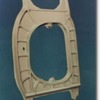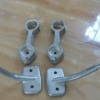Aluminum alloy forging
1.Alloy: 5083/6061/7049/7050/7075/7175
2.Closed Die Forging/Open Die Forging/Precision Ring Rolling
Aluminum Forgings | | Aluminum Forgings are generally used in applications where the high integrity of the part is of utmost importance. They are used primarily for structural components such as the intake of Gas turbine engines where light weight is crucial. In automotive applications, forged components are commonly found at points of shock and stress. |
|
Aluminum Alloys | | 2014/2219/2618/5083/6061/7049/7050/7075/7175 And Others |
|
High Strength | | In making a forging, the metal is worked twice under tremendous pressures. First during rod extrusion, drawing or rolling and then during forging. The double working under pressure, compacts the metal, and produces a very dense and refined grain or fiber structure. The tensile strength of the parts is thereby increased, and resistance to impact and abrasion is enhanced. | | Leak Resistance | | The dense non-porous forged metal permits the designer to specify thinner sections without the risk of leaks. Often, the thinner forged parts result in lighter weight and lower piece cost compared to other manufacturing processes. | | Close Tolerances | | A forging produced in a steel die with close tolerances offers several advantages. Overall part dimensions are held closer than in sand casting. Dimensions show minimum variation from part to part allowing for automatic chucking and handling in subsequent operations. The precise designs on the die surface can produce sharp impressions on the forging surface, which is normally not the case with other forming processes. | | Low Overall Cost | | Mass production of forged parts lends itself to maximum savings. However, smaller quantities of copper alloy forgings can also prove economical when specific design parameters must be met. These requirements include leak integrity, close tolerances, high strength with low weight, and non-symmetrical shape. |
|
|
aluminum forging tube /ring







